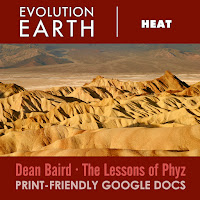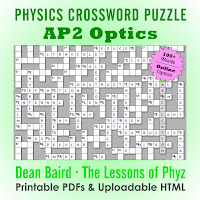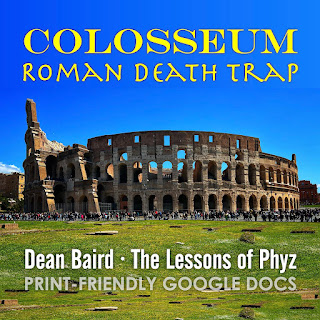My high school physics and science curriculum at TPT, Pearson Education, Arbor Scientific, and PhET
Thursday, December 14, 2023
The Lessons of Phyz Advantages - Crosswords
Monday, December 11, 2023
Chemistry Crossword Puzzles [OpenStax-aligned]
Monday, November 27, 2023
The Battle to Beat Malaria
Malaria is one of humanity’s oldest and most devastating plagues. In many parts of the world, it remains an ever-present scourge that sickens or kills millions of people each year. What if it could finally be defeated? Now, scientists may be on the verge of a breakthrough with a promising vaccine in the final stages of testing and approval. Follow researchers on a quest to deliver humankind from one of the world’s deadliest diseases.
Wednesday, November 15, 2023
Inside China's Tech Boom
In the span of just a few decades, China has transformed into a science and technology superpower. But how did it get here and where is it headed? Take an insider’s tour of high-profile tech companies and labs that are driving China’s meteoric rise to the forefront of global innovation. How does China innovate? What drives its bid for technological supremacy? And what does its rise mean for the future of the global economy?
Monday, October 23, 2023
Evolution Earth
Evolution Earth embarks on a global expedition to reveal the animals keeping pace with a planet changing at superspeed. Heading out across the globe to distant wilds and modern urban environments, five episodes track how animals are moving, using ingenuity to adapt their behavior, and even evolving in unexpected ways.At the front lines of this rapid change are the scientists, filmmakers and local communities recording the animals’ stories. We follow heart-warming tales of resilience that redefine our understanding of evolution, and hint at how nature can show us a path towards a sustainable future for Planet Earth.The series is narrated by Dr. Shane Campbell-Staton, who guides us through each episode in an intimate narrative style, drawing on his background as an evolutionary biologist.
At Earth’s extremes, animals are reacting in surprising ways. Animal homes are changing around them at superspeed. Follow remarkable stories of resilience and hope. From humpback whales to tiny butterflies to ingenious savanna chimpanzees.
Islands are like miniature simplified Earths, where evolution is playing out at super speed right before our eyes. Journey from the Galapagos to the edge of Antarctica to seek out animals responding to our changing planet in extraordinary ways.
Travel to the hottest and driest extremes to see animals go to extraordinary lengths to survive. From the Sahara Desert to Australia, animals provide new clues about our changing planet and what it will mean for the future of our heating world.
At the planet’s frozen extremes, shifts in animal movement and behavior reveal vital information about our future world. Examine polar bears in the Arctic, penguins in Antarctica and other animals surviving in icy worlds.
Wednesday, October 11, 2023
Advanced Placement Crossword Puzzles
Tuesday, October 10, 2023
Ancient Earth
Witness the dramatic history of Earth, from its birth to the emergence of humanity. Dive into the most dramatic events in Earth’s 4.5-billion-year history, from its birth to the emergence of humanity. How did a hellscape of molten lava transform into a lush, green, watery planet filled with life? With dazzlingly realistic animation based on the latest research, each of these five episodes brings to life long-lost worlds that ultimately led to the one we know today.
Today, Earth is enveloped by a thin veil of gas, a narrow band of atmosphere that protects a world covered in lush green vegetation, deep blue oceans, and abundant life. But 4.5 billion years ago, Earth was a very different place: a hellscape of molten lava and barren rock, under relentless bombardment from meteors, and with no atmosphere whatsoever. So how did our familiar blue sky come to be? Breathtakingly realistic animations and a chorus of science experts reveal how the primordial inferno first gave rise to an orange-hued cauldron of toxic gasses that would be deadly to us today. Witness how the first drops of rain splashed down on the searing planet, setting the stage for the evolution of life. And discover how life itself helped create the air we all breathe today.
Cover photo: Baroness viewpoint on Floreana Island in the Galápagos, when I was there in 2008 during The Amazing Adventure 3 with James (The Amazing Randi).

700 million years ago, Earth was a giant snowball cloaked in ice from pole to pole – a global deep freeze that held the planet in a stranglehold, threatening the survival of the earliest complex life. How did life manage to hold on in this forbidding world? Leading scientists investigate how this catastrophe may have become a catalyst for life to evolve in creative new ways as it bounced back from the brink – setting the stage for the astonishing complexity we see today.
Cover photo: The pack ice in the Arctic Ocean from the M/S Origo, summer 2018.
For billions of years, life teemed in the oceans of planet Earth while the land was desolate and inhospitable. So how did life make the leap to land? Scientists explore how some of the earliest life emerged and invaded a barren, rocky landscape, eventually transforming it into a verdant, green world. Gripping visual effects reveal an alien landscape dominated by towering fungi before the arrival of plants. Witness how the first plants made landfall and partnered with fungi to create soil that would sustain them. And discover how, once life emerged on land, it fundamentally altered the very ground it grew on.
Cover photo: A riparian landscape taken while looking for jaguars in the Pantanal of Brazil's wild west, summer 2016.
252 million years ago, the most devastating mass extinction of all time abruptly wiped out around 90% of all species on Earth. The culprits were the biggest volcanic eruptions the world has ever seen, emitting some 700 thousand cubic miles of magma and rock. Volcanic gasses permeated the atmosphere and acidified the oceans while toxic gasses destroyed the ozone layer, bathing the planet in destructive UV radiation. The event–now called “The Great Dying”–came close to wiping out all life on the planet. Follow scientists as they piece together geologic evidence from the deep past and clues from today’s ecosystems to discover how life made it through and evolved into the astonishing variety we see around us today.
The story of Earth can only be told because now, 4.5 billion years into its existence, a technological and self-aware animal species roams its surface, able to study the very planet that gave rise to it. But how exactly did Earth give rise to humans? Through stunningly realistic animation, witness the cataclysmic asteroid strike that wiped out the dinosaurs, the tumultuous changing climates that allowed early primates to spread across the planet, and the geologic events that created the conditions for the evolution of an animal that walks upright on two legs. Explore the power and paradox of humanity’s profound impact on our planet, and ponder the question of how we may shape its future.
Cover photo: Newspaper Rock in southeast Utah, as I saw it in April, 2004.
Saturday, September 23, 2023
Human Nature
Sunday, September 10, 2023
Physics Crossword Puzzles [Conceptual Physics]
Friday, September 8, 2023
Making North America
Wednesday, August 30, 2023
What's the Universe Made Of?
Tuesday, August 29, 2023
Great Electric Airplane Race
Thursday, August 24, 2023
Ending HIV in America
Monday, August 21, 2023
Petra: Lost City of Stone
Thursday, August 17, 2023
Hagia Sophia: Istanbul's Ancient Mystery
Tuesday, August 15, 2023
Can Psychedelics Cure?
Saturday, August 12, 2023
Hidden Volcano Abyss
Monday, August 7, 2023
The Story of Maths
Tuesday, July 25, 2023
Digital Remastering: The Summer Work of 2023
Sunday, July 2, 2023
The Lessons of Phyz Advantages
Monday, June 26, 2023
The Brain
Neuroscientist David Eagleman explores the human brain in an epic series that reveals the ultimate story of us, why we feel and think the things we do. This ambitious project blends science with innovative visual effects and compelling personal stories, and addresses some big questions. By understanding the human brain, we can come close to understanding humanity.
Monday, June 19, 2023
Our Planet II
Saturday, June 10, 2023
Colosseum: Roman Death Trap
Crypto Decoded
From Bitcoin to NFTs, crypto is making headlines. But what exactly is it, and how does it work? Experts go beyond the hype and skepticism to unravel the social and technological underpinnings of crypto – exploring how it came to be and why this new technology may change more than just money.




































